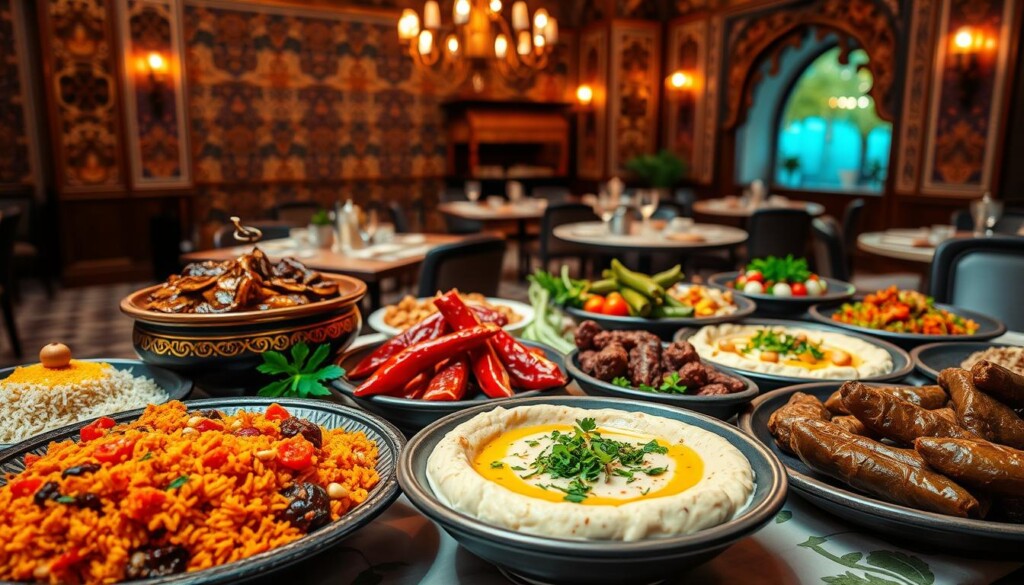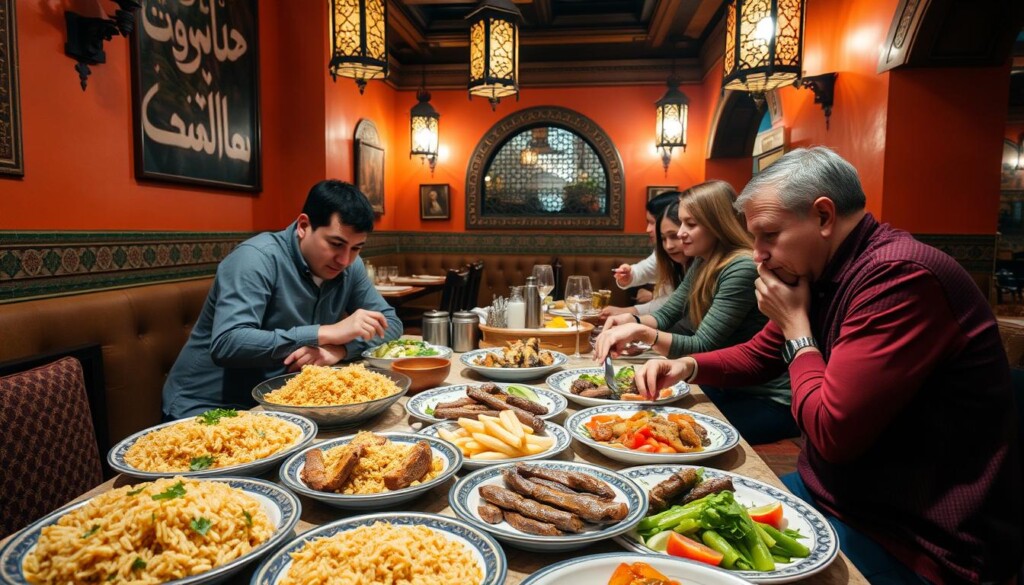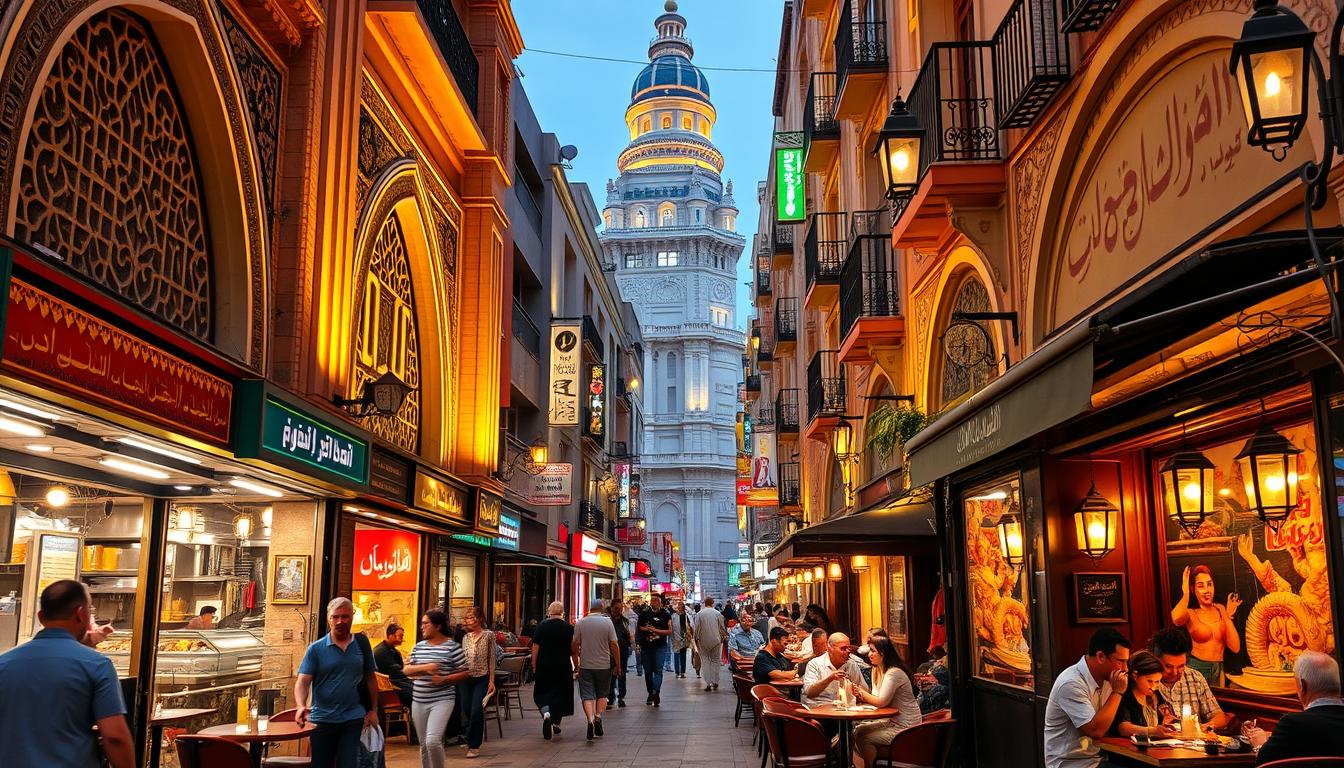Have you ever wondered why Arabian food restaurants are so popular in the US? Middle Eastern cuisine is becoming more loved, bringing authentic Arabian dining to the table. These places offer a wide range of dishes, from savory to sweet, sharing Arabian culinary traditions with everyone.
They focus on healthy meals and offer many Halal options. This makes them great for anyone looking for a new and exciting dining experience. Let’s dive into the best spots for Arabian food in the country.
Key Takeaways
- Arabian food restaurants are gaining popularity across the United States.
- Middle Eastern cuisine offers a rich variety of flavors and dishes.
- Authentic Arabian dining experiences feature healthy meal options.
- Many Arabian restaurants provide certified Halal dining choices.
- These establishments serve as cultural representatives in diverse communities.
- Fragrant spices and traditional recipes define Arabian culinary traditions.
The Allure of Arabian Cuisine
Arabian cuisine is loved for its rich flavors and varied ingredients. At its core, Arabic dishes use grains, meats, spices, and legumes. These are key to creating the unique taste of the Mediterranean.
Fresh herbs like parsley and mint add vibrant and aromatic notes. Tahini and high-quality olive oil are also important. They help shape the distinct taste of Arabian cuisine.
Key Ingredients in Arabian Dishes
Grains like rice and bulgur are the base of many meals. Spices such as cumin, coriander, and sumac add layers of flavor. Lean meats, like lamb and chicken, are marinated in these spices before cooking.
Legumes, including chickpeas and lentils, are staples. They provide protein and heartiness. Fresh herbs and seasonal vegetables add color and nutrition, making each bite full of taste and texture.
Traditional Cooking Techniques
Traditional cooking methods are key in Arabian cuisine. Grilling and baking in clay ovens bring out different flavors. The slow-cooking process, used for stews, lets spices blend and deepen.
These techniques enhance the natural flavors of ingredients. They result in meals that are vibrant and satisfying. Each method shows the cultural heritage in Arabic dishes.
Popular Arabian Food Restaurants in Major US Cities
Exploring the best Arabian restaurants across major US cities shows the diversity of Middle Eastern cuisine. Each place offers a unique dining experience with authentic flavors and new dishes. The culinary scene ranges from New York’s busy streets to Los Angeles’ lively vibe and Chicago’s welcoming feel.
Best Arabian Restaurants in New York City
In New York, Mamoun’s Falafel is famous for its legendary falafel. It wins the hearts of both locals and visitors. Tanoreen is also well-known for its creative take on traditional Arabian dishes, blending flavors perfectly. These spots are the heart of Arabian dining, drawing those who love authentic tastes.
Top Picks in Los Angeles
Los Angeles is known for its lively food scene. Bavel wows diners with its modern take on Middle Eastern flavors. Sunnin Lebanese Cafe offers a cozy vibe with tasty mezze and grilled dishes. Both are top choices for Arabian food fans in this food lover’s city.
Must-Visit Spots in Chicago
Chicago’s Arabian food scene is just as exciting, with Ema and Al-Nafoorah at the forefront. Ema is loved for its small plates and fresh ingredients. Al-Nafoorah offers a variety of authentic dishes that showcase traditional flavors. These places are must-visits, giving a taste of Azerbaijani dining in the city.
Unique Dishes to Try at Arabian Restaurants
Visiting an Arabian restaurant is a chance to try many unique dishes. You can enjoy different hummus flavors, tasty kebabs, and sweet Middle Eastern desserts. Each dish has its own story, blending flavors and traditions.
Hummus Variations
Hummus is a favorite in Arabic cuisine, with many tasty variations. You can try roasted red pepper hummus, avocado hummus, or the classic garlic and lemon. These hummus types are great with pita bread or veggies.
Flavorful Kebabs and Grills
Kebabs are a big deal in Arabian cuisine. Restaurants offer chicken, lamb, and beef kebabs, all marinated in spices. Grilled to perfection, they are a hit with meat lovers, showing off Middle Eastern grilling skills.
Delectable Desserts
The meal ends with delicious desserts that show off Arabic sweets. Baklava, with its nut and syrup layers, and knefeh, with its cheese base, are just a few treats. These desserts are a sweet finish to your meal, showing the art of Arabic dining.

How to Choose the Right Arabian Restaurant
Choosing a restaurant can be fun but also tricky, mainly when it comes to Arabian food. Location and ambiance are key to a great dining experience. They set the mood and make enjoying traditional Arabian flavors even better.
Consider Location and Ambiance
The restaurant’s location is important. A welcoming atmosphere makes your meal more enjoyable. Look for places that show Arabian culture through their decor and feel. This creates a unique dining experience.
Menu Diversity and Authenticity
A menu with many authentic Arabian dishes shows a restaurant’s quality. Choose places with traditional dishes and high-quality ingredients. This means the chefs are skilled and dedicated.
Customer Reviews and Ratings
Customer reviews are very helpful. Sites like Google and Yelp give insights into what others think. Look at overall ratings and comments on food, service, and ambiance. This helps make a good choice.
The Growing Popularity of Arabian Food
Arabian cuisine is becoming more popular. People want to try new foods that are rich in culture. They also look for healthy options, like vegetarian and vegan dishes.
This change shows how food trends are evolving. Traditional flavors are now mixed with modern tastes. It’s a new way of enjoying food.
Trends in Arabian Dining
Arabian food is changing fast. Restaurants are now serving both old favorites and new dishes. This mix of old and new attracts more people to try Arabian food.
This shift makes dining out more exciting. It lets people explore different tastes and traditions.
Cultural Influences on Modern Arabian Cuisine
Chefs in Arabian cuisine are inspired by many cultures. They use local ingredients and techniques. This makes Arabian food more authentic and appealing to everyone.
To find great Arabian food, check out LocalZ. They have a list of local places to eat.
The Role of Local Business Directories like LocalZ
Local business directories, like LocalZ, are key in connecting local restaurants with diners. They offer a place for Arabian food places to list and reach out to customers. This makes it easier for restaurants to be seen and for diners to try new places.
Connecting Communities with Local Restaurants
LocalZ is a bridge between communities and their local eateries. It helps people find Arabian food spots they might not know about. Users can look for certain types of food or find places near them, showing off the area’s food variety.
Benefits of Listing with LocalZ
Listing on LocalZ has many perks for restaurants and the community. Restaurants get more visibility online, making it simpler for people to find them. Plus, LocalZ gives some of its money to local groups. This helps the community and supports local businesses, creating a positive cycle.

How LocalZ Works for Consumers
LocalZ makes finding Arabian food restaurants easier. Users can start a LocalZ search to find places that fit their taste. They can filter by location, cuisine, and dietary needs.
Searching for Arabian Food Restaurants
LocalZ helps customers find Arabian food restaurants near them. It simplifies the search, showing a list of options based on location. This ensures diners find the perfect spot for their meal.
Filtering Options and Reading Reviews
LocalZ lets users filter search results by price, ambiance, and dishes. Reading reviews is key in choosing a restaurant. It helps users make informed decisions. For more details, visit LocalZ.
Supporting Local Businesses with LocalZ
LocalZ is key in building community ties by linking people to local eateries and services. It shows its dedication to local businesses by giving 50% of its yearly fees to local groups. This move boosts local economies and motivates people to help their neighborhoods grow.
Giving Back to the Community
Using LocalZ helps customers support community projects while enjoying Arabian food. This cycle of support benefits both businesses and the community. When people eat at local spots, they help the local economy and enjoy unique Arabian dishes.
Building Local Connections
LocalZ helps people feel more connected to their community. It turns every meal at a local restaurant into a chance to support community projects. This shared goal creates a strong, supportive local environment, showing why supporting local businesses is so important.
The Experience for First-Time Diners
Visiting an Arabian restaurant is a special treat for first-timers. The atmosphere is lively, with bright decor and soft lighting. Traditional music adds to the charm, making it a perfect place to try new flavors.
What to Expect at an Arabian Restaurant
First-timers will find a welcoming space where sharing meals is common. The menu is full of tasty dishes, from juicy kebabs to creamy hummus. The enticing smells and beautiful setting will make you want to try everything.
Tips for Trying New Dishes
Trying new dishes is key to a memorable meal. Start with appetizers to taste a variety of flavors. Asking the staff for suggestions can also help. They can point out popular dishes and hidden treasures.

Arabian Food for Special Occasions
Arabian cuisine is a big part of big celebrations and events. It brings people together, celebrating traditions. Restaurants offer catering with Arabian food, pleasing many tastes.
Whether it’s weddings, birthdays, or cultural festivals, Arabian food makes any event special. It turns simple gatherings into unforgettable moments.
Catering Options for Events
Choosing Arabian catering adds a unique touch to any event. Favorites include lamb kebabs, flavorful rice, and spiced pastries. These dishes delight everyone and create a shared experience.
Many catering services can customize for any event size. They ensure each dish highlights Arabian culinary traditions.
Celebrating Cultural Festivals with Food
Arabian dishes at cultural festivals deepen our understanding of traditions. Sharing meals strengthens community bonds and showcases Middle Eastern flavors. Events like Eid and Ramadan feature festive meals that honor these customs.
Food brings joy and celebrates cultural heritage. It makes festivals a feast for the senses and spirit.
Exploring Vegetarian and Vegan Arabian Options
Arabian cuisine has a lot to offer for those who follow a vegetarian or vegan diet. There are many tasty plant-based dishes to try. These dishes show off the cooking skills of Arabian chefs and give vegetarians lots of choices.
Falafel, tabbouleh, and baba ghanoush are some of the most loved dishes. They are known for their great taste and texture. Both vegetarians and meat-lovers enjoy them.
Popular Plant-Based Dishes
Falafel is a tasty treat that’s crispy outside and soft inside. It’s perfect as a snack or a main dish. Tabbouleh is a fresh salad with parsley, bulgur, and veggies. It’s a great side dish.
Baba ghanoush is a smoky eggplant dip. It’s rich in flavor and goes well with pita bread or veggies. These dishes are key to vegan Arabian cuisine. They let everyone enjoy delicious food without worrying about their diet.
Restaurants with Vegetarian-Friendly Menus
More Arabian restaurants are adding vegetarian options to their menus. They show their support for vegan Arabian cuisine by serving a variety of plant-based dishes. This move attracts more customers and celebrates the variety of Arabian food.
People can find many local favorites that make vegetarian meals exciting. These restaurants are helping to make vegetarian dining more enjoyable.
Final Thoughts on Arabian Food Restaurants
Visiting local Arabian food restaurants is key to diving into Arabian culinary traditions. It’s not just about tasting food; it’s about supporting businesses that keep traditions alive. This helps the local economy and brings people together through food.
Exploring Arabian cuisine is more than eating; it’s about discovering heritage and celebrating diversity. Each dish has its own story, thanks to ancient cooking methods and fresh ingredients. By trying these dishes, people connect with the food and the people who make it, making meals more than just food.
In the end, Arabian food restaurants offer more than just food. They encourage us to appreciate Arabian traditions and build community. By choosing to eat at local spots, we help create a vibrant scene of flavors and stories. This enriches our culture and inspires us all.

